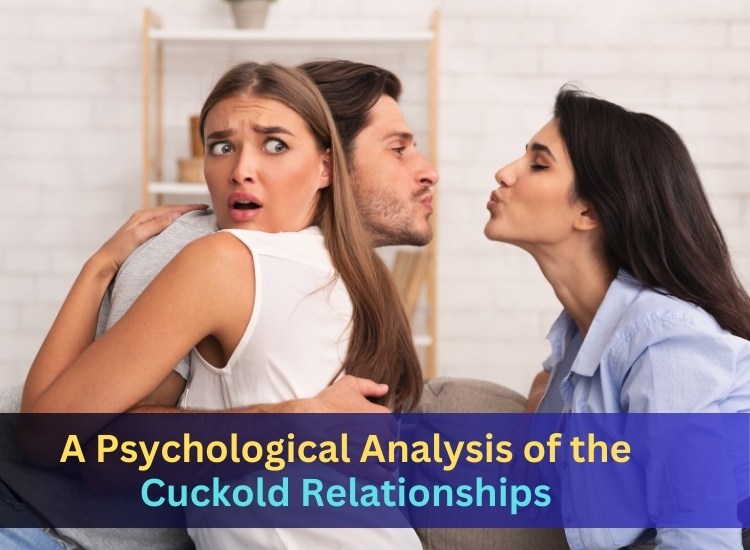*You open the door to the bathroom and enter. Stephanie gets slammed against the glass shower door, her tits and face pressed up against the foggy shower door. You see a tall muscular man behind her. Ramming her.* ”Oh FUCK yes, Howard! Fuck me harder, Howie! Make me scream! I want you at least twice before my boyfriend comes home!”
HOME
In our current political climate, the term “cuck” – short for “cuckservative” – has become an insult of the so-called alt-right, aimed at men they view as spineless and emasculated. The slur has its roots in the concept of cuckolding, or having an adulterous partner.
But, according to a recent study by David Ley, Justin Lehmiller and the writer Dan Savage, acting on cuckolding fantasies can be a largely positive experience for many couples, and hardly a sign of weakness.
Cuckolding can be a thrilling way to explore intimacy and desire, but it's not without risks. You'll need to navigate emotions like jealousy and insecurity, which can arise even in the most trusting relationships. Open communication and clear boundaries are essential to guarantee both partners feel safe and respected. When done right, cuckolding can deepen emotional connections, heighten sexual satisfaction, and empower both partners to embrace vulnerability. It's a journey that requires honesty, trust, and a willingness to grow together. If you're curious about how to make it work, there's plenty more to uncover about this dynamic experience.
Key points
- Female infidelity has a long history of stigma and shame.
- Cuckolding and other forms of female non-monogamy have gotten more attention in mainstream media.
- As shame and stigma decrease, people find healthy, positive ways to integrate sexuality into their lives.
In 2008, I first encountered couples who lived what they called the “hotwife” or “cuckold” lifestyle. While I had worked with sexuality issues for many years, I was unfamiliar with this phenomenon. In this lifestyle, the men in these heterosexual relationships encouraged their wives to engage in sexual relations with other men, while the husbands were most often monogamous. In cuckolding, there is often an element of male submission or humiliation involved, whereas in hotwifing, the men are equal partners, and there’s no humiliation involved. My initial reaction was to assume that this practice reflected unhealthy relationships, disturbed attachment, and sexual problems.
1. Understanding Cuckolding: What it Means and Why People Engage in it
Cuckolding is a unique and complex dynamic that involves one partner (referred to as the cuckold) deriving pleasure from watching their partner engage in sexual activities with someone else. This practice can stem from a variety of motivations, including sexual arousal from feelings of humiliation, submission, or voyeurism. It is essential to understand that Cuckolding is consensual and requires open communication and trust between all parties involved.
2. Fantasy vs. Reality: The Transition from Imagination to Actual Experience
Cuckolding is a unique and complex relationship dynamic that involves one partner deriving pleasure from their partner engaging in sexual activities with others. This practice is rooted in trust, communication, and consent, and it has gained increasing attention in recent years. Below is a synthesis of key insights from the search results, organized into relevant themes:
1. Definition and Core Concepts
-
What is Cuckolding?
Cuckolding is a consensual non-monogamous relationship where one partner (often referred to as the "cuckold") derives emotional or sexual satisfaction from their partner (the "cuckoldress" or "hotwife") engaging in sexual activities with others, known as "bulls." This dynamic often involves elements of power exchange, voyeurism, and compersion (finding joy in a partner's pleasure). -
Key Characteristics
-
Consent and Communication: All parties must agree to the arrangement, with clear boundaries and ongoing dialogue to ensure emotional well-being.
-
Power Dynamics: Cuckolding often includes a submissive role for the cuckold, who may experience feelings of humiliation or arousal from their partner's activities.
-
Emotional Resilience: Trust and emotional support are crucial to navigating potential challenges like jealousy or insecurity.
-
2. Psychological and Emotional Aspects
Cuckoldry is a controversial topic that has been the subject of many discussions and debates in recent times. It is a situation in which a man’s wife or partner engages in sexual intercourse with another man while the man himself either consents to it or is unaware of it. The concept of cuckoldry has been around for centuries and has been portrayed in literature, art, and media.
However, the psychology behind why some men are drawn to or even enjoy the idea of their partners being with someone else is still not fully understood. The phenomenon of cuckoldry raises several questions about human sexuality, psychology, and relationships.
In this blog post, we will explore the psychology of cuckoldry, including the reasons why some men are drawn to this fetish, the impact it may have on their relationships, and how it can affect their mental health. We will also examine the role of power dynamics in cuckoldry and how they can influence the behavior of all parties involved.
Introduction
The cuckold lifestyle is a type of relationship in which one partner enjoys watching their partner engage in sexual activities with someone else. It’s a unique and often misunderstood form of non-monogamous relationship, and it can be an incredibly fulfilling and rewarding experience for both partners involved. In this article, we will explore the implications of the lifestyle, how to discuss interests with your partner, finding others who share your interests, setting ground rules for your relationship, and practicing self-care.









